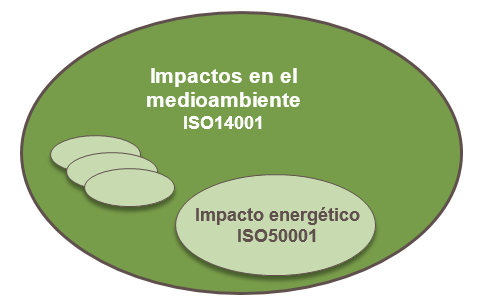Numerous companies that are already certified with the ISO14001 Standard are currently considering what advantages implementing an energy management system based on ISO 50001 can bring them and how these two systems, which at first glance seem to pursue common objectives, coexist.
Goals
The goal of an ISO 14001 is the implementation of an environmental management system that helps the company to reduce its impact on the environment, while the objective of ISO 50001 is the implementation of an energy management system that improves the energy performance of the organisation. Unlike sustainability certifications such as LEED or BREEAM, which both pursue the same objectives, ISO 14001 and ISO 50001 have completely different objectives, although the results sought are aligned.
ISO 14001 specifies criteria for environmental management systems and provides a framework specification for organisations to assess and improve their environmental impact without establishing a methodology for monitoring energy performance.
Whereas ISO 50001, the energy management standard, focuses specifically on the ability of organisations to manage energy resources and energy use.

The ISO 50001 provides an adequate methodology to improve the energy performance of the organization.
ISO 50001 sets out how to plan, implement, evaluate and review an energy management system with energy performance indicators. These indicators allow measuring, independently of other parameters, the results of the planned energy improvement actions and monitoring through a continuous energy audit process.
Main differences
ISO 50001 focuses exclusively on energy management and provides a framework of requirements that enables organisations to use data to better understand energy use and consumption, thereby improving their energy efficiency. It is based on the ISO continuous improvement management system model, and is designed to be compatible with existing management system standards such as ISO 9001 and ISO 14001.

ISO 50001 can be used in conjunction with other ISO management standards to help identify energy savings opportunities, or it can be used independently in the case, for example, of organisations that are particularly concerned about energy costs.
Advantages of integrating both certifications
Organizations that are already applying an ISO management standard can easily integrate the ISO 50001 standard into their management systems. The same tools and techniques can be used for common activities of ISO 14001 and ISO 50001, such as document management, audit planning, corrective measures, and general management. A good example is the audit and corrective action management processes of ISO 14001, which can also be used for the same processes of ISO 50001.
The advantages of this integration are:
- An organisation's ISO management procedures can easily be adapted to form a single integrated system, reducing the flow of information and duplication of documents.
- Better management of resources and time, as it reduces the standard administration time that can be spent on identifying and exploiting energy savings opportunities.
- More dynamic workflow as it allows for better teamwork and energy savings measures and their approval can be managed more efficiently and faster.
- Better control of documents thanks to audit history, energy savings measures and results.
- Less duplication of documents in all management systems.
- Quicker and easier location of information so that records are not lost, and relevant information is delivered to the right recipients.
- Easier planning of management activities (e.g. audits, meetings, measurements) with reminders when the date is approaching.
- Faster implementation of energy efficiency measures
- Ability to follow up certifications.
- Standardised methods for processing environmental and energy savings suggestions.
- Efficient and strategic management of goals and objectives.
- Automatic reporting to monitor energy efficiency improvements.
How does ISO 50001 work?
The ISO 50001 standard is based on the same continuous improvement cycle as the other ISO standards. Therefore, to achieve an integration of the different standards, it is necessary to bring all the different teams under the leadership of a single integrated management system manager, to have a management team consisting of two people, the energy manager and a management systems specialist, and to create interdisciplinary teams capable of identifying and implementing improvement opportunities.

Future objectives in the integration of ISOs
It is expected that shortly the main body of the regulations will include some common clauses, and each individual management category its own specific text. So that an organisation can easily integrate multiple standards into a single management system with various specialized sections —a certification section for quality, one for safety, one for energy, and so on— to make certification easier to manage.


